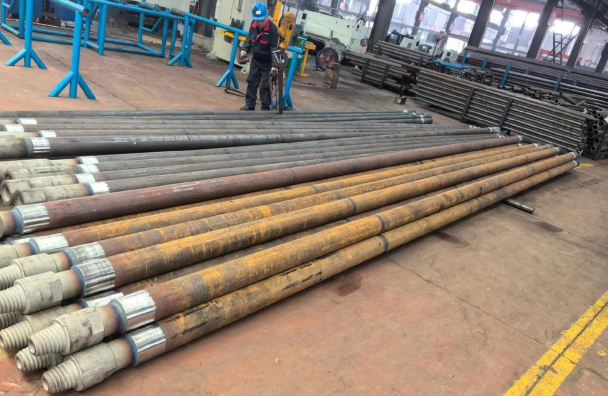Drill pipe is a critical tool in oil and gas drilling operations, used to transmit torque and drilling fluid. Its price is influenced by a variety of factors. The following are the main components of drill pipe prices and the factors influencing its cost:
Drill Pipe Price Composition:
The total cost of drill pipe typically consists of the following:
1. Raw Material Cost: Fluctuations in the price of steel (such as AISI 4145H alloy steel) directly impact drill pipe costs. Component: 40%-60%
2. Manufacturing Cost: Process costs such as heat treatment, machining (friction welding, thread turning), and non-destructive testing. Component: 20%-30%

3. Coating and Anti-Corrosion: Surface treatments such as copper plating, phosphating, and spraying enhance corrosion resistance. Component: 5%-10%
4. Transportation and Tariffs: International transportation (sea/air) and import tariffs (such as the US anti-dumping duties on Chinese drill pipe). Component: 5%-15%
5. Certification and Testing: API certification and third-party inspection fees (such as SGS and BV). Component: 2%~5%
Key factors affecting drill pipe prices:
(1) Raw material prices
Steel type:
Ordinary drill pipe: using ordinary carbon steel, the cost is lower and the price is more affordable.
Made of high-quality alloy steel (such as 35CrMo, 42MnMo7), the cost is higher and the selling price is also higher.
AISI 4145H alloy steel (medium carbon chromium-molybdenum alloy steel, mainstream choice).
High-strength drill pipe: S135 steel grade (for deep wells, the price is higher).
Corrosion-resistant drill pipe: containing Cr-Mo alloy (such as G105), the cost increases by 10%~20%.
Market fluctuations: Changes in iron ore and coke prices directly affect steel costs.
(2) Specifications and Design
Drill Pipe Size and Weight:
The larger the outer diameter (e.g. 2-7/8″, 3-1/2″, 5″), the thicker the wall, and the longer the length, the more material is used, the more complex the manufacturing process, and the higher the price.
Heavy Weight Drill Pipe (HWDP) is 20% to 40% more expensive than conventional drill pipe.
Drill Pipe Steel Grade:
E75, X95, G105, S135. The higher the steel grade, the higher the yield strength and the more expensive the price.
Connection Type:
API standard connectors (e.g.
NC26, NC38) are relatively low in cost.
High-end connectors (e.g. VAM, TORQUE MASTER) price doubles.
(3) Production process cost
Manufacturing process:
Seamless drill rod: excellent performance, high price, 20%~30% more expensive than welded drill rod.
Friction welding drill rod: mainstream process, moderate cost.
Heat treatment: The drill rod undergoes quenching and tempering treatment (quenching + tempering), which increases the cost but improves the strength.
Processing accuracy: The price of drill rods processed by CNC machine tools is 15%-30% higher than that of traditional processes.
Inspection standard: Ultrasonic testing and magnetic particle inspection of the entire process of drill rods increase the cost by 5%~10%.
(4) Market supply and demand and policies
Industry prosperity: When oil prices rise, demand for drill pipes surges and prices rise.
Trade barriers:
The United States imposes anti-dumping duties on
Chinese drill pipes (up to 400%).
Localized procurement policies, such as Saudi Aramco's requirement that some drill pipes be produced locally.
Exchange rate fluctuations: RMB depreciation may increase the cost of imported drill pipes.
(5) Additional services and lifespan
Coating technology:
Ordinary phosphating coating: low cost.
Nano coating or copper plating: extends lifespan, but the price is 30% to 50% higher.
Used drill pipe: The price is 30% to 60% of new drill pipe, but the remaining lifespan affects the cost-effectiveness.
The operating environment may increase costs:
Geological complexity: Hard rock or karst formations increase drilling difficulty, leading to higher equipment and labor costs.
Groundwater level: Areas with high water levels require additional waterproofing measures, which may increase costs.
Strategies for reducing drill pipe costs:
1. Bulk purchasing: Sign long-term agreements with
drill pipe manufacturers or suppliers to lock in prices.
2. Design optimization: Select the appropriate steel grade based on well depth to avoid over-provisioning.
3. Local supply: Reduce transportation and tariff costs (e.g., Chinese manufacturers supplying the Central Asian market).
4. Maintenance to extend lifespan: Regularly inspect and repair thread wear to reduce replacement frequency.
Conclusion:
Drill pipe prices are influenced by five major factors: raw material prices, specifications and design, production processes, market supply and demand, policies, and additional services. Procurement requires balancing performance requirements with cost, focusing on steel grade, joint type, and corrosion protection technology. Amidst oil price fluctuations and supply chain uncertainty, flexible procurement strategies, such as mixing new and used drill pipe, can effectively control costs.
Read more: API 5DP Drill Pipe Specification or Casing Pipe Price & Cost


